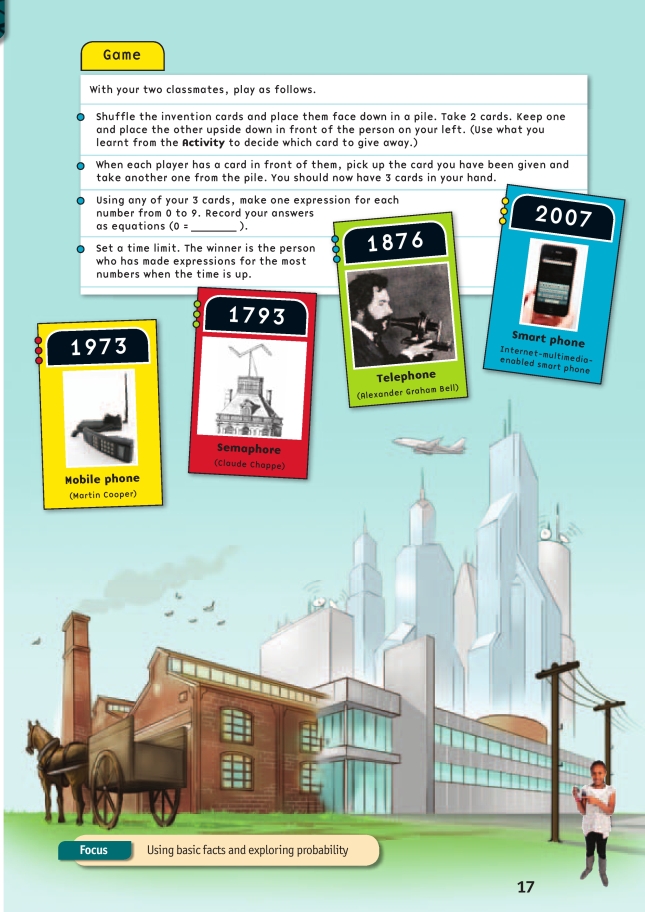This is a level 2-3 activity from the Figure It Out series.
A PDF of the student activity is included.
Click on the image to enlarge it. Click again to close. Download PDF (330 KB)
Most games involve a mixture of strategy and luck. Sometimes the need for a strategy only becomes apparent after starting the game. In this activity and game, students make expressions using four numbers. The goal is to create expressions that are equal to the numbers 0 to 9. By exploring different sets of four numbers, students can identify whether some dates provide fewer options than others and then use this information to develop a strategy for playing the game. Of course, there is not much they can do about luck!
2 classmates
a set of Communication Progress cards (see copymaster)
The activity and game provide an opportunity to practise basic facts.
When working with numbers and operations, there are a number of conventions about the order of operations. These conventions are summarised by the acronym BEDMAS: brackets, exponents, divide and/ or multiply, add and/or subtract. For example, when using these conventions, 2 + 3 x 4 = 2 + 12; without the conventions, students would read this 2 + 3 x 4 as 5 x 4. Students at this level are not expected to use these conventions, so brackets have been used in the examples below to make them mathematically correct. If you want to extend some of your students, group them together and have them apply the conventions to their expressions.
Examples of equations that can be found using the digits in 1843:
0 = 8 – 4 – 3 – 1
1 = 8 – 4 – 3 x 1
2 = 8 – 4 – 3 + 1
3 = (8 ÷ 4 – 1) x 3
4 = 8 ÷ 4 + 3 – 1
5 = 8 ÷ 4 + 3 x 1
6 = 8 – 4 + 3 – 1
7 = (4 – 3) x 8 – 1
8 = (4 – 3) x 8 x 1
9 = (4 – 3) x 8 + 1
The students may fi nd it helpful to use digit cards to identify possible equations, changing the order of the digits as they explore possible equations.
Discuss the special roles that 0 and 1 play. For example, 0 can be used to eliminate other digits, and it has no effect on the total when it is added or subtracted. A 1 can be used to create three consecutive numbers, for example, 1 = 3 x 2 – 4 – 1, 2 = (3 x 2 – 4) x 1, 3 = 3 x 2 – 4 + 1. Remind students that you can’t divide a number by 0. This is a mathematical rule.
Encourage students to investigate why some dates offer a much greater range of possible equations than others. They could analyse all the dates on the cards and present their findings to the class.
It may seem strange to students to write an equation with “the answer” on the left side of the = sign, for example, 5 = 3 + 2 + 1 – 1. Many students interpret the = sign as “the result when you solve a problem”. Remind the students that the = sign means “is the same as”. Understanding this at an early age will help them use this symbol correctly when they are introduced to more complicated equations.
Evaluating the usefulness of each set of 4 digits develops the key competency thinking.
Technology-related student activities
- The students research the evolution or development of a particular technology, such as flying machines.
- They investigate a particular inventor, such as John Britten, or the inventions of an earlier civilisation such as ancient Rome.
- Challenge the students to go without a particular technology, such as television, for a period of time. They report on their experiences and how they overcame any problems that arose.
- Ask students to imagine a world without telephones, television, or radios. They can research other ways to communicate, such as Morse telegraphs, pigeons, and semaphore.
- Have students explore http://science.howstuffworks.com/innovation/inventions/10-inventions-thatchanged-the-world.htm
Exploring the technology-related context
Very few inventions are the result of one person’s or group’s endeavours. Many technologies are modifications of previous efforts, sometimes from hundreds of years ago. Research into the history of some everyday technologies can reveal fascinating insights into their development. For example, see http://inventors.about.com/od/astartinventions/a/FamousInvention.htm
Communication technologies have progressed rapidly in the last hundred years. Earlier expensive, large, and unreliable systems have given way to robust and efficient systems that can be accessed by most people.
Answers
Activity
1. Depending on which card you use, you may or may not find an expression to match each number between 0 and 9. Each card can be used for several different numbers, but some dates provide fewer options than others.
2. Answers will vary.
3. a.–b. Answers will vary. Years with zeros, for example, 2007, tend to have a smaller range. This is because 0 either eliminates values (2 x 0) or has no impact (2 + 0).
Game
A game using basic facts.

